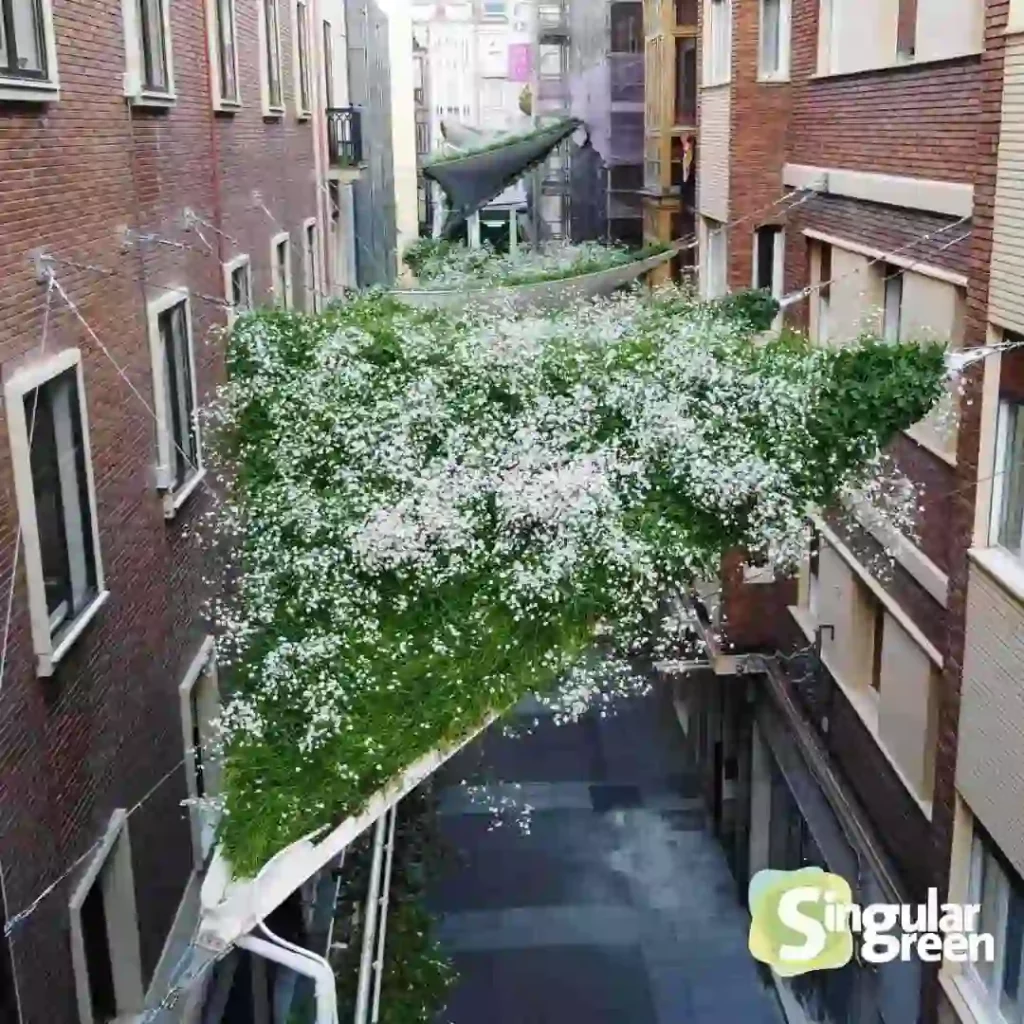The vegetated sail awnings are nature-based solutions integrated into the city of Valladolid, specifically on Santa Maria Street.
We invite all architecture and nature enthusiasts to take a walk along the street and throughout the green corridor created in the city.
For those who may not know, nature-based solutions are a new concept that involves urban interventions using nature to provide us with services in a more economical and ecological way.
How did the project emerge?
The plant canopy project is part of a European initiative, Horizon 2020, where SingularGreen is involved as a partner. This Horizon 2020 project, called UrbanGreenUP, takes place in three European cities: Liverpool, Izmir, and Valladolid.


In all these cities, the aim is to use nature-based solutions to address specific problems that arise in urban areas. In the case of Valladolid, along with the other partners, we designed a green corridor that runs through the entire historic center of the city.
Generally, the historic centers of cities tend to have narrow streets, which pose various challenges for introducing vegetation through the installation of planters or planting trees. This was precisely the case with Santa Maria Street; it was a very narrow street that did not allow for the conventional integration of nature, as it complicated vehicular access.
What could we do in the face of these challenges?
We considered developing a system of plant canopies. Plant canopies are a solution that allows us to introduce nature into hard-to-access streets without any impact, both during construction and afterwards, and without occupying the roadway. In other words, it’s a way to bring nature into urban spaces with minimal construction impact.
What’s most interesting about this project is its originality, as it offers the possibility of integrating nature virtually anywhere in a city.

How do they work?
To explain how plant canopies function, we will follow the water cycle of the plant canopies.
We will start by discussing how the canopies collect rainwater. Each of the canopies collects rainwater that flows through a drainage pipe to a vegetated beam that runs along the entire street until it reaches a kiosk.
The kiosk already existed but was unused, so we rehabilitated it and installed all the irrigation centralization and water storage inside it.

From the storage tanks, the canopies are watered again. The pumps integrated into this kiosk are responsible for pushing the water back through irrigation pipes installed along the vegetated beam, reaching the top of the canopies where drip emitters are installed to irrigate the vegetated canopies. Any excess water is recirculated for greater efficiency.
Structure of the Plant Canopiestados
Having explained how the plant canopies function, I would like to divide their structure into two parts: the vegetated canopies and the beam.
The Canopies
he plant canopies are anchored on both sides of the building facades using cables and specific anchors. Each of these anchors has been tested and structurally sized to ensure that the different facades can withstand the load. When anchoring the canopies to the facades, each facade received specific treatment.
We did this because it was very important for the project that street life was not disrupted by the installation of the plant canopies. Therefore, the installation team carried out the entire installation from a cherry picker without interrupting the opening of shops or the passage of pedestrians.

The Vegetated Beam
The vegetated beam runs the entire length of the street, as mentioned in its function, providing installation for both the canopies and the drainage back to the kiosk.
Specifically, the vegetated beam is a continuous planter that establishes an ecological corridor along the street. We came up with the idea of planting it with hanging and climbing plants so that as all the species grew, they would cascade down both sides of the beam, creating a sort of green cylinder. Additionally, we wanted the plants to climb up the tubes to reach the canopies, thereby creating a comprehensive green intervention.

The Most Interesting Aspect of the Project
We have managed to grow vegetation in the canopies with a thickness of just 3mm, and we are able to project it. We use our patented LeafSkin system to project the seeds, and from there, they grow rapidly.
All the installations in the street (electricity, water) run through the vegetated beam. One of the most important things we accomplished was the elimination of street lighting, which we integrated into the continuous planter. This optimization reduced the number of lamps from 20 to 8, which are now smart and adjustable, leading to lower energy consumption.
It is a comprehensive project that takes into account all aspects, from social factors to minimize impact on local businesses and enhance the street’s appeal, to technical and natural considerations.






